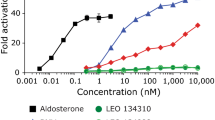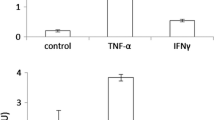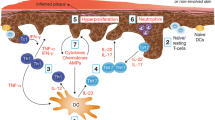Abstract
Purpose. Pharmacodynamic characterization of topical glucocorticoids as prednicarbate (PC), its metabolites prednisolone 17-ethylcarbonate (PEC) and prednisolone (PD), betamethasone 17-valerate (BMV), beta-methasone (BM) and desoximetasone (DM) by evaluating their effects on epidermal and dermal cells. Synopsis of pharmacokinetic and pharmacodynamic studies, possibly explaining the improved benefit-risk ratio of prednicarbate.
Methods. Isolated foreskin keratinocytes were used to investigate the influence on epidermal inflammatory processes, dermal fibroblasts of the same origin to study antiproliferative activities of glucocorticoids. Interleukins were measured by ELISA-assay, the influence on II-lα-production also on mRNA-level by RNAse protection assay. Proliferation was assessed by 3H thymidine incorporation and biodegradation by HPLC/UV-absorption. Cell viability was controlled by MTT assay.
Results. In keratinocytes, inflammation was induced by TNFα, resulting in an increased II- lα synthesis. This cytokine was particularly suppressed by PC and BMV, whereas PEC, PD, DM and BM were less potent (p ≤ 0.05). Since, however, the double ester PC is rapidly degraded in keratinocytes, a RNAse-protection assay of II-1α mRNA was performed allowing short incubation times and thus minimizing biodegradation effects. In agreement with the previous experiment, the antiinflammatory potency of native PC was confirmed. In fibroblasts, II-lα and II-6 synthesis indicate proliferation and inflammation respectively. Whereas PC inhibited II- lα and II-6 production in fibroblasts to a minor extent only, it was strongly reduced by the conventional glucocorticoids and PEC (p ≤ 0.05). The minor unwanted effect of PC on fibroblasts was also reflected by its low influence on cell proliferation as assayed by 3H thymindine incorporation. More pronounced antiproliferative features were observed with BM, PEC and espectially BMV.
Conclusions. Correlating antiphlogistic effects in keratinocytes (suppression of II-lα) with antiproliferative effects in fibroblasts (suppression of II-lα and II-6), the improved benefit−risk ratio of PC compared to conventional glucocorticoids does not result only from distinct drug metabolism in the skin but also from a specific influence on the cytokine network.
Similar content being viewed by others
REFERENCES
M. Schäfer-Korting, H. C. Korting, M. J. Kerscher, and S. Lenhard. Clin. Pharmacol. Ther. 54:448–456 (1993).
M. Schäfer-Korting, M.-H. Schmid, and H. C. Korting. Drug Safety 14:375–385 (1996).
P. J. Dykes, S. Hill, and R. Marks. Assessment of the atrophogenic potential of corticosteroids by ultrasound and by epidermal biopsy under occlusive and nonocclusive conditions. In E. Christophers, E. Schöpf, A. M. Kligman, and R. B. Stoughton (eds.), Topical corticosteroid therapy. A novel approach to safer drugs, Raven Press, New York, 1988, pp. 111–19.
H.-C. Korting, D. Vieluf, and M. Kerscher. Eur. J. Clin. Pharmacol. 42:159–161 (1992).
R. Niedner and E. Schöpf. Clinical efficacy of topical glucocorticoid preparations and other types of dermatics in inflammatory skin diseases, particularly in atopic dermatitis. In H. C. Korting and H. I. Maibach (eds.), Topical glucocorticoids with increased benefit/risk-ratio, Karger, Basel, 1993, pp. 157–169.
A. Aliaga, M. Rodriguez, M. Armijo, J. Bravo, A. López Avila, J. M. Mascaro, J. Ferrando, R. Del Rio, R. Lozano, and A. Balaguer. Int. J. Dermatol. 35:131–132 (1996).
C. L. Kutsch, D. A. Norris, and W. P. Arend. J. Invest. Dermatol. 101:79–85 (1993).
M. Goldring and S. R. Goldring. Critical reviews in eukaryotic gene expression 1:301–329 (1991).
N. Auphan, J. A. DiDonato, C. Rosette, A. Helmberg, and M. Karin. Science 270:286–290 (1995).
R. I. Scheinman, P. C. Cogswell, A. K. Lofquist, and A. S. Baldwin. Science 270:283–286 (1995).
A. Ray and K. Prefontaine. Proc. Natl. Acad. Sci. USA 91:752–756 (1994).
R. W. Groves, T. Rauschmayr, K. Nakamura, S. Sarkar, I. R. Williams, and T. S. Kupper. J. Clin. Invest. 98:336–44 (1996).
T. S. Kupper and R. W. Groves: J. Invest. Dermatol. 105:62S–66S (1995).
I. L. A. Boxman, C. Ruwhof, O C. Boerman, C. W. G. M. Löwik, and M. Ponec: Arch. Dermatol. Res. 288:391–398 (1996).
M. Pagé, N. Bejaoui, B. Cinq-Mars, and P. Lemieux. J. Immun. Pharmacol. 10:785–793 (1988).
T. Nishida, N. Nishino, M. Takano, K. Kawai, K. Bando, Y. Masui, S. Nakai, and Y. Hirai. Biochem. Biophys. Res. Commun. 143:345–352 (1987).
H. Wong, W. D. Anderson, T. Cheng, and K. T. Riabowol. Anal. Biochem. 223:251–258 (1994).
J. Y. Tso, X. H. Sun, T. H. Kao, K. S. Reece, and R. Wu. Nucl. Acids Res. 13:2485–2502 (1985).
A. Gysler, K. Lange, H. C. Korting, M. Schäfer-Korting. Pharm. Res. 14:793–797 (1997).
M. Ponec. Glucocorticoid receptors. In H. C. Korting and H. I. Maibach (eds), Topical glucocorticoids with increased benefit/risk ratio, Karger, Basel, 1993, pp. 20–28.
M. Ponec. Arch. Dermatol. Res. 275:334–344 (1983).
G. Würthwein, S. Rehder, and P. Rhodewald. Pharmazeutische Zeitung Wissenschaft, 4:161–166 (1992).
Ch. M. Bamberger, A.-M. Bamberger, M. DeCastro, and G. P. Chrousos. J. Clin. Invest. 95:2435–2441 (1995).
M. Schäfer-Korting. Topical glucocorticoids: What has been achieved? What is still to be done? In H. C. Korting and H. I. Maibach (eds.), Topical glucocorticoids with increased benefit/risk ratio, Karger, Basel, 1993, pp. 192–201.
Author information
Authors and Affiliations
Corresponding author
Rights and permissions
About this article
Cite this article
Lange, K., Gysler, A., Bader, M. et al. Prednicarbate Versus Conventional Topical Glucocorticoids: Pharmacodynamic Characterization In Vitro. Pharm Res 14, 1744–1749 (1997). https://doi.org/10.1023/A:1012183914011
Issue Date:
DOI: https://doi.org/10.1023/A:1012183914011




